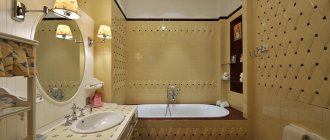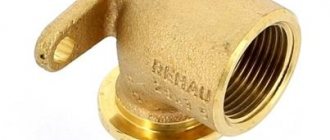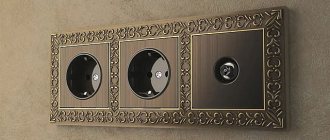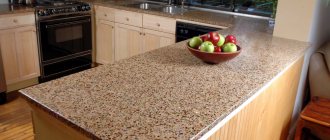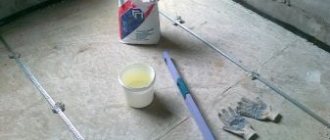Those who are renovating a bathroom, changing its design, are interested in information about what is the optimal height of the bathtub from the floor (the standard that exists today, does it allow changing the parameters) and how the installation of plumbing fixtures made of different materials differs.
Bathroom design.
Improper installation may result in equipment leaking, instability, falling or overturning.
Types of baths
There is a wide range of bathtubs on the sanitary equipment market.
Each buyer can purchase a model he likes, made of steel, cast iron, acrylic, or a new sanitary ware product - a quarry product. You can also choose the bathtub volume, width and length. The choice depends on the size of the bathroom, personal preferences and financial capabilities of the consumer. The steel option is considered the most affordable. This bathtub is light in weight and does not cause problems during transportation. The use of steel as a manufacturing material allows the product to be given different geometric shapes. But the service life of such a bath is short, since it does not sufficiently withstand mechanical stress. The product does not hold heat well and makes a lot of noise.
The classic tank is a heavy tub made of cast iron. This product is characterized by reliability and durability. It does not have a wide variety of shapes, but can have an original design. Water poured into a cast iron bath retains heat for a long time. Prices for these products are several times higher than for steel products.
In recent years, the types of tanks described above have been replaced by acrylic bathtubs, which have become very popular. They are lighter in weight, but at the same time retain heat excellently. High-quality acrylic products can last at least 10 years. The height of the acrylic bathtub from the floor is standard.
The advantage of this product is a large selection of colors and shapes. But the presence of numerous intricate lines leads to a decrease in strength indicators. Since there are no pores on the surface of acrylic, pathogenic microorganisms do not multiply in such a bath.
A pleasant novelty on the plumbing equipment market is products made from the composite material quaril, which includes:
- quartz;
- acrylic;
- polymer additives.
The long service life of these baths justifies their high cost. Quaril is a hygienic material with a hard surface and resistance to ultraviolet radiation. Models made from it are heavier than acrylic products - their weight reaches 50 kilograms. The cost of quaril baths is quite high, since they are produced exclusively in Europe.
Let's talk a little about the structure and principle of operation of a jacuzzi
The times are not so far away when the presence of a jacuzzi in a house was a sign of the owner’s wealth. Today, such a hot tub is found in many homes and serves as a necessity, allowing you to relax and recuperate after a hard day at work.
Watch the video
But purchasing such a device is only the first and not the most difficult step. The main thing is to install it correctly. Naturally, you can invite an experienced specialist, but after studying the procedure in detail, you can cope with this task yourself.
The hydraulic massage bath consists of the following main elements:
- a bowl-shaped vessel, also called a font;
- hole for water intake;
- nozzles for releasing water jets and air;
- piping of the hydromassage system and aeration network;
- pumping station for pumping liquid through the hydromassage system;
- compressor for intake and pumping of air in the aeration system;
- drainage hole for transferring runoff to the sewer system;
- adjustment and control unit;
- support system with position regulators during installation;
- mixing device for adjusting the water temperature while filling the font;
- Remote Control.
The operating principle of a hydromassage device is simple - the bathtub is filled with water at the desired temperature through a mixer, and some of the liquid enters the piping of the hydromassage system.
The pump creates pressure, and the liquid bursts out of the nozzles at high speed, exerting a massaging effect on the human body.
In addition to this effect, you can turn on the aerator and get additional air action in the form of a pure stream or mixed with water. The entire process is controlled by a pneumatic or electronic system.
Modern hydromassage installations are equipped with additional functions intended for various purposes - playing music, radio, television, as well as creating color effects. Air aromatization, ozonation and other options are possible.
Standard bath sizes
When choosing a bathtub, it is important to take into account several operational factors, the main one of which is its dimensions. A bathroom of incorrect dimensions will cause clutter in the room, reduce the functionality of the room and, most likely, cause significant discomfort.
The key criterion when determining the size of the structure is whether it is comfortable to take a bath. Convenience is a highly subjective criterion that varies from person to person and depends on body type, height, duration and preferences for taking hygiene procedures. Therefore, the length, width, height and depth for bowls are in the following range:
- length varies from 150 to 180 cm;
- fixed width indicators - 70-85 cm;
- depth and height can reach 65 cm.
Bathtubs are divided into small, medium and large sizes:
- small – from 120 to 130 cm in length and 70 cm in width;
- medium - from 140 to 150 cm in length and 70 cm in width;
- large - from 170 to 185 cm in length and from 70 to 85 cm in width.
Standard bathtub sizes: no matter what calculations
In this case, you should pay special attention to several aspects on which a comfortable position in the bathtub depends:
- It is preferable that during hygiene procedures a person can take a reclining position. To do this, choose a bathtub that can accommodate your outstretched legs.
- The width of the bathtub should also be proportionate: the standard is calculated taking into account the volume of the human body and at least 5 cm to the sides on each side when a person is immersed in water.
- The depth of the bowl will differ for different designs, but the most preferred parameters are 50-60 cm. This bath depth is the standard for safely positioning the body in the water and the head above its surface.
- Bathtubs, similar in appearance, often differ in volume. This is due to the angle of inclination of the internal walls, as well as the presence or absence of armrests and sides.
- Bathtubs that exceed standard sizes not only increase water consumption and the time it takes to fill and drain, but are also considered less safe. Therefore, we recommend installing bathtubs of standard dimensions, which have been tested over many years of use.
The dimensions of bathtubs depend not only on the regulations and standards applied to them, but also on the material from which they were made.
How to choose a bathtub size
First of all, the proportionality with the bathroom is taken into account. The width of the latter should at least correspond to the largest dimensions of the plumbing fixtures plus one centimeter on each side. For small bathrooms up to 4 m², wall and corner tanks are suitable. Round ones are installed in rooms from 8 m². The relevance of the bathtub dimensions for a particular bathroom is determined by calculating the available area. The dimensions of the space for a washing machine and washbasin, toilet, if any, are subtracted from the overall indicator. The resulting result is used to determine the maximum allowable width of the bath along the protruding edges, as well as the largest area it occupies. In square bathrooms, calculating the space for the bowl will not cause difficulties, but in the case of oblong options, much depends on the placement of the sink and household appliances. The length of the plumbing will most likely have to be coordinated with the narrow side of the room.
It will be better if you plan everything in advance: if necessary, the machine can be moved to the kitchen or placed under the sink countertop.
Hydraulic testing of pipes
After all water and sewer pipes have been laid and all requirements for the placement of water outlets have been met, it is imperative to test the pipeline or, as experts call it, pressure testing.
Pressure testing must take place under increased pressure of 10 atmospheres using a special press. To do this, all water outlets, except the farthest one, are closed with plugs (they will later protect the pipes during finishing), and a ball valve is screwed into the farthest water outlet.
The system is filled with water, then shut off and a special crimping press is connected to the tap. The tap opens and a pressure of 10 atmospheres is injected into the pipeline using a press (all pressure testing machines are equipped with pressure gauges).
If the pressure does not drop within several hours, then the system can be considered sealed and can be safely walled up. If not, then you should find the leak, fix the problem and test again.
CONCLUSION
After laying the pipes and carrying out hydraulic tests, you can begin finishing – tiling the bathroom with ceramic tiles. The installation of plumbing fixtures should be carried out at the final stage.
Properly done piping in a bathroom using modern pipes and technologies will serve its owner for decades.
What dimensions should sewer outlets have to install different plumbing fixtures? Dimensions of sewer pipe outlets for plumbing connections
In previous articles, the rules that must be followed when installing plumbing were discussed. Now let’s figure out what sizes of sewer pipe outlets
.
The shower cabin and bathtub are connected to the sewer using specially designed corrugations and pipes or tees with a diameter of 50 mm (see photo below). The level of the outlet from the wall of a pipe with a diameter of 50 mm should be 60 mm (from the level of the floor tiles to the axis of this pipe):
If this distance is higher, then you will have to build a podium for the bath.
For a washbasin (sink), the height of the sewerage system from the floor (pipe outlet from the wall) should be 530...550 mm from the level of the clean floor to the axis of the pipe:
For an attached toilet – 180…190 mm (depending on the model):
For a wall-mounted toilet – 220…240 mm.
For a kitchen sink without a chopper – 300…450 mm.
For a kitchen sink with a chopper – 300…400 mm.
For washing machine and dishwasher – 600…700 mm.
(all distances are given from the level of the clean floor to the axis of the pipe)
Let me clarify: the above values are common, standard, but with today’s variety of companies and models, it is necessary to approach each case personally.
If you want to install some new, exclusive plumbing equipment, then you should first look at the technical map of installation and connection dimensions specifically for this equipment. This must be done earlier than supplying water and laying a drainage ditch - so as not to have to redo it, therefore it is better to purchase the desired plumbing fixtures in advance (if there is space for storage).
By the way, the sequence of all repair measures depends on the type of bathtub. If the bathtub is ordinary, then first it is installed itself, and then the room is tiled. If the bathtub has a hydromassage device, then everything is done the opposite: the bathtub is installed last.
How many bathrooms are needed? If we are talking about an apartment with an open plan, then first you need to impartially assess the dimensions of the place, as well as the locations of the risers to which all plumbing equipment will be connected. As a standard, it is better to equip two separate bathrooms - a guest and a master (again, if space allows). The guest room will only have a toilet and sink.
Naturally, residents living in houses with a standard layout do not have the ability to make several bathrooms, so you just need to decide the question: is it really necessary to bother with remodeling the bathroom or should you just limit yourself to replacing plumbing equipment and cosmetic repairs?
In the following article there is still little information about installing plumbing fixtures with your own hands.
in the light of water supply and sewerage design. Namely, about electronic sockets in the bathroom.
Effect of materials on size
The parameters of the font often depend on the material from which they are made. Manufacturers are often limited by the capabilities of their existing equipment. Cast iron, steel and acrylic are usually used to make bathtubs.
Cast iron products are extremely popular. They can retain heat well for a long time. The disadvantage is that cast iron plumbing is too heavy. The product is installed on cast supports attached to the body. Bowls are available in three sizes:
- miniature sitting baths can have a length from 100 to 130 cm, a width of 70 cm, a depth of half a meter, the volume of such models is 140 liters;
- medium models usually reach 150 cm in length, and in width - from 70 to 75 cm, in height - half a meter, the container holds up to 170 liters of liquid;
- large comfortable bathtubs have standard dimensions (170x75 cm), height 50 cm and volume 195 liters, although there are modifications with dimensions 185x85 cm.
The most affordable option is steel plumbing. Buyers are attracted by the lightness of the models. This type of plumbing product is easy to install yourself. The dimensions of steel structures are no different from their cast iron counterparts. The longer the font, the more comfortable it is. The standard height is 40-60 cm. Steel is easier to process than cast iron, so you can find steel oval, round, corner and rectangular designs. The disadvantages include the rapid cooling of water and noise when filling the container with liquid.
The acrylic model is made from fiberglass and covered with a 3-4 mm layer of acrylic on top. A lightweight, durable box can have a length from 120 to 190 cm, a width from 70 to 170 cm, a height from 38 to 65 cm. The largest design holds 400 liters of liquid. The parameters of acrylic bathtubs do not always comply with standards. There are curved and rounded shapes of the models.
The bathtubs are secured using adjustable screw feet to special supports. Polymer sides have low thermal conductivity, so the liquid in the hot tub does not cool down for a long time. Asymmetrical acrylic modifications are in demand. Some designs are equipped with headrests and handrails. The corrugated surface of the bottom prevents slipping.
The downside is the fragility of the acrylic product, the sides are especially vulnerable. Proper installation of the bathtub can eliminate this disadvantage.
Cast iron bathtubs - advantages and disadvantages
Products made of cast iron have a particularly durable structure. They do not deteriorate from impacts and temperature contrasts. In high-quality cast iron bathtubs, the enamel layer fits tightly to the tank and does not leave pores. Enamel retains color for a long time. The coating can withstand the effects of strong cleaning agents, but abrasives are still best avoided.
The heavy weight of the products should be put first on the list of disadvantages. Bathtubs place serious stress on the flooring. The internal structure of the material makes it difficult to create unusual shapes.
Rectangle and oval are a few traditional options. Unlike acrylic containers, water cools faster in cast iron containers: literally in 10-15 minutes, although in this sense they are better than steel ones. Among other things, enamel coatings lose their integrity from impacts.
A few more positive qualities of cast iron:
- The products do not require special care or careful monitoring of their condition.
- The material absorbs noise well. The sound of falling water will not disturb those around you.
Sizes and shapes
The width of cast iron bathtubs is 70 or 75 cm - this is true for most reclining models. Sedentary bathtubs are wider than 80 cm. The largest semi-reclining bathtub had dimensions of 190x85 cm and was considered the most comfortable before the spread of Jacuzzis began. The dimensions and markings of cast iron plumbing fixtures are in GOST 18297-96. Baths made of this material are designated by the abbreviation HF. The standard model HF-1500 is considered a classic. Its length is 1500 mm, width - 700, and depth (height) from the top edge of the sides to the bottom - 400 mm. The HF-1600 modification, in accordance with the name, has a length of 1600 mm, and its remaining parameters correspond to the HF-1500 version. The HF-1700 model has a length of 1700 mm, a width of 750 mm and a depth from the top of the side to the bottom of 400 mm. The diameter of the drain holes is 52 mm.
Steel
The most economical option would be a steel bathtub. Such models are relatively light in weight - up to 30 kilograms. Also, steel baths have thin walls, the thickness of which does not exceed 3 mm.
Its length ranges from 150 to 180 cm, its width varies from 70-85 cm, the height of this model is 65 cm. The standard dimensions of a steel bathtub are indicated in the table (see the figure for designations).
| L | L1 | L2 | H | S | |
| 120 | 1200 | 550 | 1060 | 380 | 700 |
| 140 | 1400 | 550 | 1250 | 400 | 700 |
| 150 | 1495 | 695 | 1322 | 400 | 710 |
| 160 | 1595 | 770 | 1422 | 400 | 710 |
| 170 | 1695 | 840 | 1522 | 400 | 710 |
Acrylic
Acrylic bathtubs have only recently been sold on the market, but have already managed to attract the attention of numerous buyers with their positive aspects. Such bathtubs have a high heat resistance and can be installed indoors without any problems. The standard dimensions of an acrylic bathtub are shown in the following figure.
Quarilic
Quaril bathtubs stand out among other models due to their high strength. In addition, this type is distinguished by a special surface that remains clean for a long time. Such bathtubs have dimensions similar to acrylic models.
Should I follow the standard?
Most builders, finishers and plumbers are well aware that the standard, optimal height of a bathroom sink is 85 cm.
These standards were developed and tested back in Soviet times, but are still observed, especially when arranging bathrooms in administrative and commercial buildings. When renovating a private apartment, if necessary, you can deviate from the generally accepted installation standard.
In conclusion, I would like to say that inside your apartment, and even more so in a private house, you have the right to install a sink inside the bathroom at any height convenient in specific conditions.
Whether or not to follow installation standards is up to you to decide. However, years of practice and scientific research confirm that, after all, a height of 85 cm is the most optimal option for the convenience of all family members, proven over the years.
Basic principles of container installation
Before installation, the height of the bowl is determined based on knowledge of the height of the youngest person living in the house. The installation height is affected by the material used to cover the walls. If a tiled coating is used, then it is worth considering the tiled parameters. When installing a bathtub with a height of sixty centimeters, tiles are laid in several rows on an area with the same area, without leaving a residue.
Main installation requirements:
- Maintaining the horizontal position of plumbing fixtures. Inspection is carried out using a building level, guided by the side of the container, which is attached to the wall.
- The wall with the side of the bowl should form a right angle. Using a large triangle, this parameter is periodically checked.
Attention! The installation of the bathtub on the floor covering must be level. Next, the bowl legs are adjusted, a siphon is attached, and the drain system is set up.
Metal spacers, which are plates measuring 100 x 100 x 5 millimeters, ensure the horizontal position of the sides of the container. Installing a gasket under the plumbing supports is a prerequisite when performing installation work on a base that is softer than the screed. For example, on laminate or parquet, wood flooring.
Without metal gaskets that form rigidity under the base, the structure will sag over time.
Reference! In Russia they produce bathtubs of standard sizes 1.5 by 0.7 meters, or 1.5 by 0.5 meters. Imported products are made in a larger format, usually 1.8 by 0.8 meters.
Determining the height of the bowl of the structure ensures the normal operation of the siphon, with a built-in water seal; for this it needs a space equal to 15 centimeters.
General installation rules
The height at which the bathtub is installed from the floor must be determined in advance. To do this, you need to know the height of the shortest person in the family.
The installation height of the bathroom is influenced by the type of wall cladding in the room. If it is a tile, then you need to know the dimensions of its sides. On an area of 60 centimeters you can lay 2 - 3 rows of facing material.
Correctly performed installation of the hot tub, taking into account the height at which the bathtub is installed, provides for:
- Its strictly horizontal location is controlled using a level, which is set along the side located near the wall.
- The angle between the side and the wall should be 90 degrees. Therefore, for installation, a large triangle will be required, allowing for constant verification of compliance with this condition.
To make it easier to ensure horizontal sides, metal spacers are used in the form of plates measuring 100x100x5 millimeters. Their presence under the supports is mandatory if the product is mounted on a base with less hardness compared to the screed, which can be laminate, parquet or wooden flooring.
In this case, the tank will sag during operation if stiffeners are not applied. When deciding at what height from the floor to install the bathtub, it is necessary to take into account that a siphon will be located under its bottom. For its stable operation, a free space of approximately 150 millimeters is required.
The height of the installed bath and possible deviations from the standards
In any case, the standards are not unconditional, so there may be some exceptions. For example, the optimal height of a bathtub from the floor in medical institutions is 50 cm.
So at what height should you place the bathtub in your home? In this matter, it is best to be guided by a sense of comfort, because the standard of 0.6 m is simply an indicator that professionals have determined to be the most favorable. The fact is that it is easy for the average person to raise their leg to exactly this height. But it is you who will use your bathtub, and not the average person; at what height to install the bathtub, try not to go beyond 0.5-0.7 m.
Keep in mind that not only entering, but also exiting the bath should be comfortable. To figure out what height to place your bathtub at, simply test it by stepping in and out of it several times.
The golden mean of bathroom heights
As in the case of sinks, the bathroom cannot be installed in any order; first of all, its design will not allow this. The permissible height above the floor to which a bathtub of a standard design can be raised does not exceed 70 cm; these are the technical restrictions introduced by the manufacturer for the standard for metal and cast iron bathtubs.
The reasons are quite obvious:
- Ensuring the stability of the metal structure;
- Reduces the risk of injury. For elderly and sick people, the standard height from the floor is limited to even 50 cm instead of the standard 60-70 cm.
For the same reasons, the height of the sides is limited; the most common steel and acrylic bathtubs have a side height of 47-55 cm. Acrylic bathtubs are much easier to manufacture than a steel or cast iron bathtub. Therefore, for people with non-standard height or build, acrylic models of increased sizes or non-standard heights are produced.
Siphon connection diagrams
Regardless of the design of bathtub sinks and methods of their installation, siphons are traditionally used:
- single-turn;
- double-turn;
- bottle.
The use of a one- or two-turn siphon is typical for “water lilies”, when it is necessary to free up as much free space under the sink as possible to accommodate a washing machine or other household items.
The name “single-double turn” was obtained due to the presence of one or two pipe bends in the circuit. Due to such bends, a hydraulic seal is created inside the line.
Another option, “bottle”, is the most common. It differs from the first in the absence of bends, the functions of which are performed by a special “bottle” with a drain pipe diverted from the top of the structure. This scheme is more convenient than the first when performing maintenance - cleaning the line in case of a blockage. At the bottom of the “bottle” there is a technical cap that can be easily unscrewed.
How to install correctly
The recommendations given by SNiP also take into account other parameters. For example, the maximum threshold in a bathroom should be 3 cm. As for the placement of the bath itself, there are two most common installation options:
- in the center of the room;
- close to the walls.
In apartments, many install bathrooms near the walls. This installation is due to the small size of bathrooms. They try to install the bathroom in such a way that there are supports of three walls around it at the same time. This is the correct safe approach. Even after slipping, a person will be able to lean against the wall while maintaining balance.
In private houses and apartments with a large square area, the distance allows the use of the second placement option. Here the bathroom is installed in the middle of the room. This design solution is considered a classic option. It gives the bathroom a more luxurious and sophisticated look. However, there is a strict standard that must be taken into account.
The distance between the edges of the side to the nearest walls must be at least 1 meter. Such passages will allow you to easily walk around the bathtub from any side, without difficulty entering and exiting it. In any case, the decision about which choice to make and where to install the bathroom should be made based on the area and design of the room.
Deviations from the norm: what to do?
Building codes and regulations that apply to bathroom equipment are advisory in nature. There are no fines for non-compliance.
However, you should not neglect the indicators at all: errors in installation can lead to overturning of the font, leaks, and human falls.
Attention: deviations in the distance to the side of 10 cm are accepted as the norm.
If people of standard height 160-170 cm live in the house, it is easier to install the font at the specified distance from the floor and walls. In non-standard cases, the values from SNiP can be varied. A bathtub is placed at 50-70 cm when people live in the house:
- mainly children, people below 160 and above 170 cm. In children's institutions, bathtubs are lowered to a distance of 50 cm, because it is difficult for children to leave a standard bathroom;
- disabled people, elderly people with mobility difficulties. It is better to choose a low font, the height of which is 45-50 cm.
Before purchasing equipment and installation, decide who will use the plumbing and take care of the convenience of each family member.
Take with you to the store the shortest member of your household who washes himself, and try to step over the side with legs.
Errors
The following omissions cause discomfort during operation:
- Failure to comply with recommended levels and spacing between equipment.
- Lack of unoccupied space at the front.
- Problems with installation marks of plumbing fixtures with sewerage and flooring.
- Unaccounted for blocking access, creating obstacles with doors, curtains, and rotating parts of equipment.
- Ignoring the individual characteristics of users: height, age, physical limitations.
People with disabilities.
Mismatch between bowl and niche sizes . With the right choice of type, the gaps between the cladding and the flanging are covered with a suitable plinth, otherwise you have to sew up the gap.
Grooving the partition.
Unaccounted for or excessive thickness of the finish makes it difficult to fit the bowl in the opening. The groove firmly holds the side, the tiles fit together beautifully, but replacing the product will result in damage to the tiles.
The non-perpendicularity of the lined panels leads to similar consequences if the linear dimensions are calculated without a margin. The corner pallet will have a wedge gap, the distortion will be noticeable under the curb.
Square check.
Slow water flow often occurs due to insufficient slope of the sewer outlet connected to the riser. Mud deposits partially block the cross-section of the pipe and reduce the original angle.
The optimal slope is maintained when assembling the site before installing the font. The gasket is controlled using a bubble level, laser tools or a cord stretched along the extreme marks.
Highly raised bowl . Maintaining the slope of the route with a remote riser results in lifting the structure - suffering when landing in the font. It is advisable to place the tank with the drain neck towards the riser, then the length of the pipe is minimal.
Excessive rise
Solution
The advice to raise the floor with a screed will entail an unwanted additional load on the floor, the difference in the threshold. It is preferable to lower the riser tee, but it will not be possible to implement the plan without destroying the tiles. The idea can be recommended for a shower room being renovated from scratch.
A thorough approach
the slope of the bathroom intentionally towards the drain, so that “the water flows out completely.” Don’t repeat the misconception: modern models have a bottom slope that eliminates any remaining liquid. The drainage problem is solved by proper sewer installation and timely cleaning of the system. An inclined installation is disharmonious with the finish, especially with tiles.
"Slide"
Horizontal alignment.
Container deformation . The situation is typical for acrylic and steel modifications installed on a flexible frame (supports). Don’t skimp on the frame; choose profiles with reserve.
Pliable supports for the acrylic model.
Many practitioners advise placing the container on a brick support and foaming the space between the slab and the bottom with foam. The solution guarantees rigidity, and the foam provides warmth and sound insulation. However, ventilation under the tank is disrupted, and access for cleaning the siphon and pipes may become worse.
"Floating" legs . The standard supports of budget products have a flimsy design; purchase a replacement, taking into account the connection method and the weight of the filled tank.
"Flimsy" supports.
Popular stick-on legs are inferior to classic types of fastening; adhesion strength depends on many factors. Defects in the floor surface are corrected before installation.
The lag of the curb occurs due to the movement of the bowl. The disadvantage is eliminated by increasing the rigidity of the structure, as suggested earlier. The edging is glued by filling the volume with water so that the structures assume a loaded position.
Hidden leaks . The screen is performed after completion of plumbing work. The tightness of the connections and the functioning of the drain are checked by completely filling the container. If the results are positive, stitching begins. They provide an inspection hatch, a movable or removable section.
The hatch (on the right) is not blocked. Sources
- https://kanalizaciyadoma.com/montazh/kakaya-vysota-vanny-ot-pola-schitaetsya-standartnoy-normy-i-pravila-montazha.html
- https://J.Etagi.com/ps/razmery-vanny/
- https://roomester.ru/interer/vannaya/razmer-vanny-standartnoj.html
- https://vplate.ru/vanna/razmery/
- https://o-vannoy.ru/vanny/razmery-vanny/
- https://iseptick.ru/santekhnika/vanny/vysota-vanny-ot-pola-standart-vysoty-ustanovki-avtosoxranennyi.html
- https://remont-om.ru/vannaya/vysota-vanny-ot-pola.html
- https://bouw.ru/article/visota-vanni-ot-pola
- https://santatrade.ru/skol-ko-vysota-vanny-ot-pola-standart/
What do you think of this article?
Marking, scoring and laying
After choosing the type of wiring, you can begin marking the pipeline routes. For polypropylene and copper pipes, all connections occur at right angles.
And for metal-plastic and cross-linked polyethylene pipes, the grooves can be laid with curves at the corners.
The grooves can be hollowed out with a hammer drill, cut with a wall chaser or a grinder with a diamond disc for stone. This is the dirtiest and dustiest stage of the work.
When laying pipes, it should be taken into account that it is customary to lay the hot pipe on top and the cold pipe on the bottom.
The size of the grooves should be such that the pipes can easily fit into the groove with thermal insulation made of foamed polyethylene placed on them, which, after walling, will compensate for the thermal expansion of the pipes.
In the space under the bathroom, it is not at all necessary to trench the wall for laying pipes; this place is already closed. To fasten pipes in grooves, you can use standard clips, but they take up a lot of space, so dowels and copper wire are often used.
In order to accurately align the water sockets of the bathtub mixer for all types of pipes, there are special mounting strips where the pipe outlets are located at a distance of 150 mm. It is recommended to use them.
When laying horizontal sections of sewer pipes, a slope of 3 cm per 1 meter of length should be observed.
When turning 90 degrees, it is better to use two 45-degree corners, with the exception of the exit to plumbing fixtures.
When assembling sewer pipes, do not forget about the cuffs, which should be lubricated with technical petroleum jelly.


